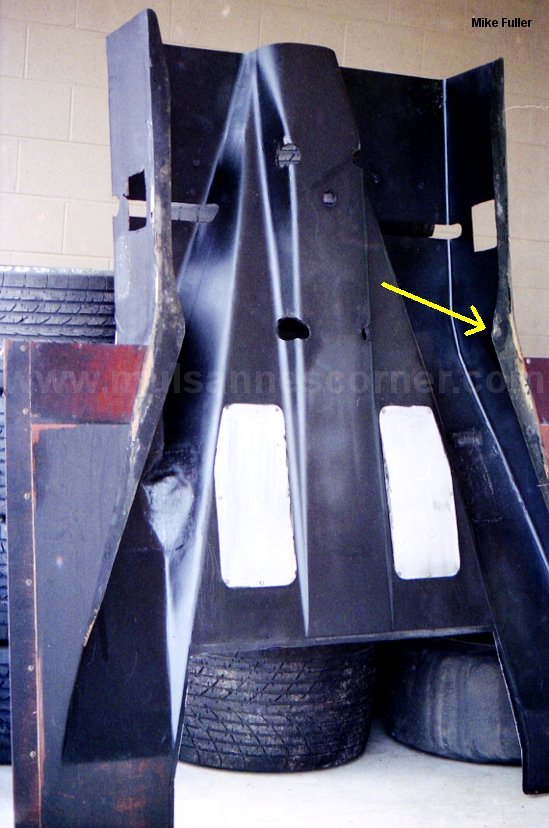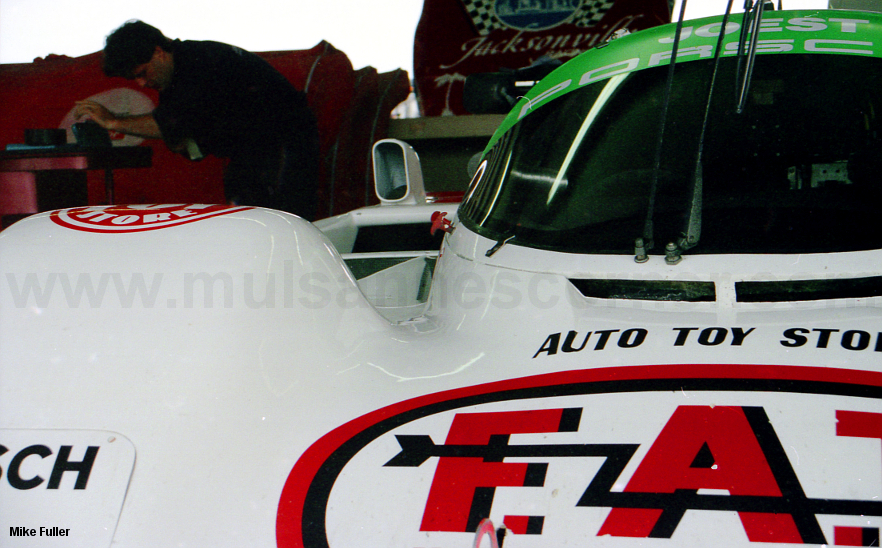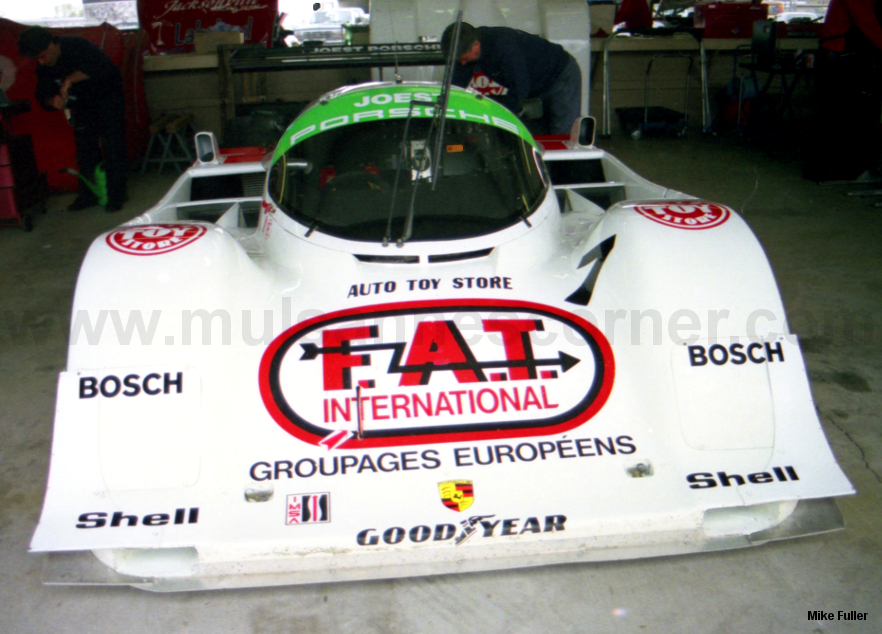 In
1989, and with the help of Norbert Singer, Joest Racing abandoned the
traditional Porche 926 factory
tail in favor of a remote rear wing which allowed a
greater freedom of adjustment and improved
overall aerodynamics. Here is the car at Sebring in 1991; the Joest
Porsche is relatively stanard but for the remote double elemet rear
wing and revised tail.
In
1989, and with the help of Norbert Singer, Joest Racing abandoned the
traditional Porche 926 factory
tail in favor of a remote rear wing which allowed a
greater freedom of adjustment and improved
overall aerodynamics. Here is the car at Sebring in 1991; the Joest
Porsche is relatively stanard but for the remote double elemet rear
wing and revised tail. Sebring
1993. The Joest team had been busy, again with Norbert
Singer as a consultant. The nose notch had been filled in and air
management
exiting the front wheel well was revised. Cooling airflow routing
and turbo induction were also modified. Joest abandoned the
Kamm-ish
rear end for a duck bill and complemented the package with a rather
impressive
twin tier rear wing. Most of these changes had race debuted in a slightly different form the
year before at Road Atlanta, though the rear wing had gone through one
final iteration (image left).
Sebring
1993. The Joest team had been busy, again with Norbert
Singer as a consultant. The nose notch had been filled in and air
management
exiting the front wheel well was revised. Cooling airflow routing
and turbo induction were also modified. Joest abandoned the
Kamm-ish
rear end for a duck bill and complemented the package with a rather
impressive
twin tier rear wing. Most of these changes had race debuted in a slightly different form the
year before at Road Atlanta, though the rear wing had gone through one
final iteration (image left). The
"Red Baron" twin-tier wing worked as two devices in one. The upper
plane
functioned
as a standard wing, running in the cleaner air at the maximum legal
height.
It could be run flatter for the same level of downforce but less
drag.
The bottom tier functioned as an under wing extractor, enhancing the
downforce
generated by the tunnels. Notice that the main plane elements
for
both the top and bottom tiers are the same profile while the flaps are
of dramatically different chord.
The
"Red Baron" twin-tier wing worked as two devices in one. The upper
plane
functioned
as a standard wing, running in the cleaner air at the maximum legal
height.
It could be run flatter for the same level of downforce but less
drag.
The bottom tier functioned as an under wing extractor, enhancing the
downforce
generated by the tunnels. Notice that the main plane elements
for
both the top and bottom tiers are the same profile while the flaps are
of dramatically different chord. With
all the work that Joest had done to the top sides it was surprising to
see that the underbody was still pretty much as the factory had
developed.
Notice the metal sheets hinting where the wide engine resides; the
width of the Porsche flat-six
motor really affected the packaging of the underwing. To that
extent, the entire drivetrain (engine, bellhousing, and gearbox) was
angled slightly to attempt make up for that deficiency.
With
all the work that Joest had done to the top sides it was surprising to
see that the underbody was still pretty much as the factory had
developed.
Notice the metal sheets hinting where the wide engine resides; the
width of the Porsche flat-six
motor really affected the packaging of the underwing. To that
extent, the entire drivetrain (engine, bellhousing, and gearbox) was
angled slightly to attempt make up for that deficiency. Also note the factory underfloor update, the horizonal extension (arrow) projecting inboard which helps enhance the vorticie shed as the air pours into the tunnel section.
 Another
view of the Joest 962C. In this case, the Atlanta IMSA GTP race
in 1993 (Road Atlanta was being paved). The vents behind the front
wheel well
have
been covered up with a flat plate to just a thin slit. Though a very small gurney lip has
been
added
to the leading edge of the slit in order to provide for some wheel well extraction.
Another
view of the Joest 962C. In this case, the Atlanta IMSA GTP race
in 1993 (Road Atlanta was being paved). The vents behind the front
wheel well
have
been covered up with a flat plate to just a thin slit. Though a very small gurney lip has
been
added
to the leading edge of the slit in order to provide for some wheel well extraction. The
cooling package is still pretty conventional. The Porsche's
coolers (water, oil, and turbo intercoolers) were
located
in the side pods and fed by intakes in the doors.
Joest modified the cooling exit by allowing some
of the air to exhaust out vents in front of the rear wheels,
the rest exiting out the engine bay at the rear. Notice the
periscope
turbo intake.
The
cooling package is still pretty conventional. The Porsche's
coolers (water, oil, and turbo intercoolers) were
located
in the side pods and fed by intakes in the doors.
Joest modified the cooling exit by allowing some
of the air to exhaust out vents in front of the rear wheels,
the rest exiting out the engine bay at the rear. Notice the
periscope
turbo intake. A double set of large
dive planes has been added to the nose to further augment front end
grip.
Note the thin splitter across the front that integrates into the lower diveplane.
A double set of large
dive planes has been added to the nose to further augment front end
grip.
Note the thin splitter across the front that integrates into the lower diveplane.
Wind tunnel development of the Joest Porsche 962C was carried out at the Porsche Weissach tunnel (full scale fixed-floor with boundary layer suction). According Ralf Jüttner, Technical Director for Joest Racing, maximum downforce for the Joest 962C was 5584 lbs. for 1396 lbs. drag (max L/D: 5281 lbs. downforce for 1200 lbs. drag). Jüttner also mentioned that, "In general, I think we were quite far off the downforce values of the Nissan and the Toyota. Anyway, I do know that downforce figures from the Weissach tunnel showed smaller values compared to other tunnels. But regardless, there was no way coming close to the Toyota as we could personally see large differences in the braking points for the first chicane at Portland for example."
| See the video of the 1993 IMSA GTP race at Atlanta Motor Speedway (right), brought to you by Marshall Pruett's website, Grand Touring Prototype. See his Vimeo channel as well for tons of IMSA GTP videos. |
GTP: 1993 Atlanta Motor Speedway Race Broadcast from GrandTouringPrototype.com on Vimeo. |
